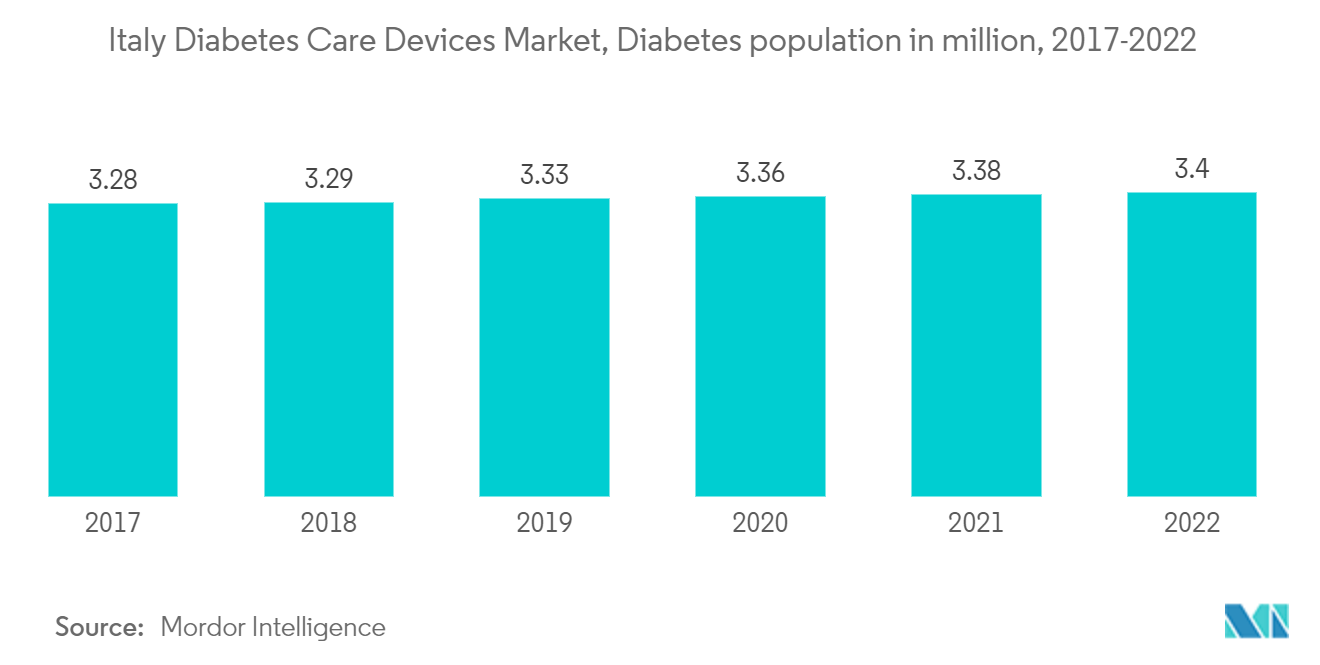Market Trends of Italy Diabetes Care Devices Industry
The continuous glucose monitoring segment is expected to witness the highest growth rate over the forecast period
The continuous glucose monitoring segment is expected to record a CAGR of more than 10.8% over the forecast period.
Continuous Glucose Monitoring Devices are automated glucose monitoring systems that consist of a small device that can be worn on the body and held on by an adhesive patch. The sensor part of the device includes a cannula inserted into the top layer of skin and uses interstitial fluid samples to check glucose levels. Sensors are connected to a transmitter that can send data wirelessly to a dedicated mobile receiving device or smartphone. CGM makes it significantly easier to manage blood glucose levels by decreasing interruptions and allowing for better sleep. It also improves the mental health of patients or caregivers by reducing the overall mental load of managing diabetes, thereby enhancing the market prospects in the coming years.
The current CGM devices show a detailed representation of blood glucose patterns and tendencies compared to a routine check of glucose levels at set intervals. These technologies overcome many limitations of self-monitoring blood glucose by fingerprick and allow one to go beyond HbA1c to check glucose control in diabetes. Furthermore, the technological advancements in continuous glucose monitoring sensors opened new scenarios to assess, off-line, the effectiveness of individual patient therapeutic plans and stimulated the development of innovative online applications. It includes hypoglycemia or hyperglycemia alert systems and artificial pancreas closed-loop control algorithms.
The Italian National Healthcare Service (NHS) is ensuring universal coverage for all citizens. People living with diabetes can access all the medicines, devices, and medical services they need with no out-of-pocket expenditure. Overall, Italy includes a well-developed system of diabetes care, with numerous diabetes centers throughout the country and treatment free at the point of delivery.
The factors above are likely to drive segment growth during the forecast period.

Insulin disposable pens occupied the highest share in the management devices segment in the current year
Insulin Disposable pens occupied the highest market share of more than 43% in the management devices segment in the current year.
A disposable insulin pen contains a prefilled amount of insulin. When the pen is empty, it is thrown away. Insulin pens are much smaller, more portable than syringes, and contain the medicine preloaded into the delivery mechanism. The needles are easy to use and can be disposed of by twisting or snapping. The pens are usually color-coded, making it easier to know which type and how much insulin will be received from them. The disposable insulin pens are considered more consumer-friendly, as they are smaller and less noticeable than the classic vial-and-syringe. These devices are also more portable for consumers. Some pens are smart insulin pens that easily connect to an app on the phone to monitor blood sugar levels and remind when to take the next insulin dose.
Italian law regulates the clinical care of people with diabetes and creates a framework involving medical organizations, prevention programs, personnel training, and legal protection. The National Health Program is structured in essential levels of assistance that can be defined differently in the various regions. The National Health Program is structured in LEAs (essential levels of assistance). LEAs define all the medical assistance modalities offered by the INHS to citizens, with or without partial contributions, based on a patient's income. The Insulin pens are free for all diabetic patients in Italy, but they must still adhere to a nominal set of medical assistance guidelines that remain free of charge.
Technological development is gaining momentum in the insulin devices market. Several technological innovations were developed over many years, creating new types of devices that are much less cumbersome and more comfortable for patients than traditional ones. Such advantages helped increase these products' adoption in the Italian market.


